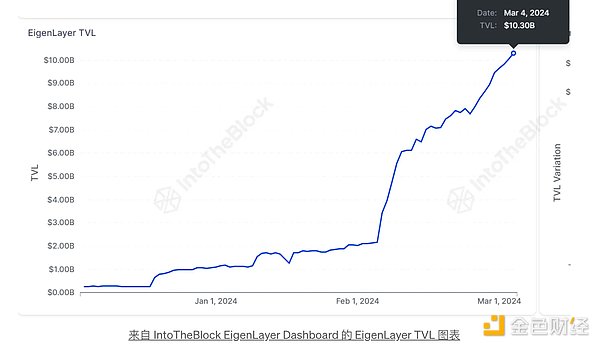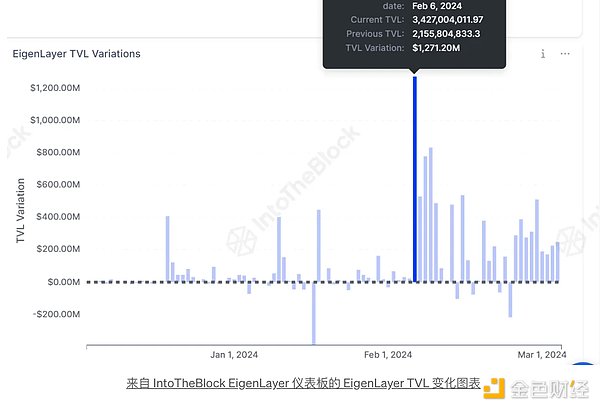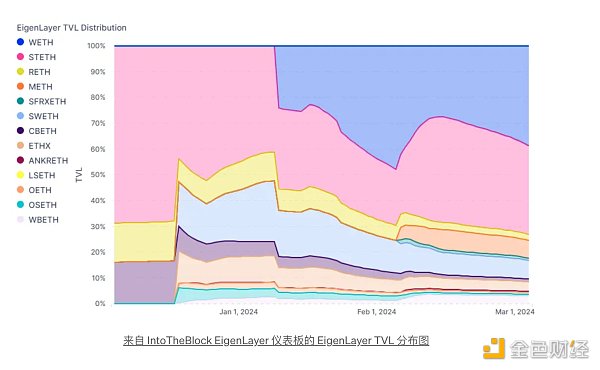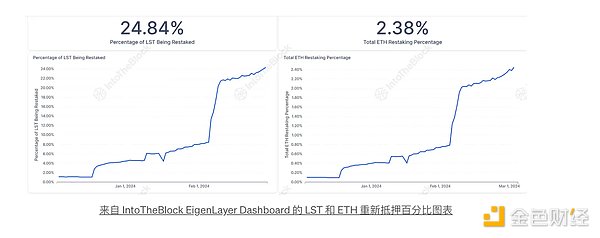Author: Juan Pellicer, researcher at IntoTheBlock Translation: Shan Oppa, Golden Finance
< p style="text-align: left;">With the emergence of EigenLayer, the Ethereum ecosystem is facing a major evolution. This innovative framework was developed by the Eigen Labs team to increase the level of security and utility across the Ethereum network. Using smart contracts, EigenLayer enables ETH stakers to expand their participation by validating a variety of new software modules. This development not only strengthens the network’s security infrastructure but also paves the way for new value creation options and innovative solutions.
Historically, blockchain has struggled with the challenge of decentralized trust. While Ethereum’s programmability efforts ushered in a new era of modular development, it resulted in a fragmented security model across various applications and services. EigenLayer attempts to unify this, providing a security umbrella for various modules from the data layer to the oracle network. Its mission is to transform EigenLAyer into a decentralized trust marketplace.
TVL is accumulating quickly
One of the best indicators of demand for EigenLayer so far is its The total value locked (TVL) realized in re-staking has exceeded $10 billion since deposits opened in June 2023. This milestone demonstrates the Ethereum community’s commitment to securing and enhancing network infrastructure with EigenLayer.

p>
Unprecedented demand
Demand for the platform reached an extraordinary level on February 6 At its peak, deposits exceeded US$1 billion in a single day. This extraordinary influx demonstrates the community's desire to participate in EigenLayer:

By examining the composition of TVL, it is obvious that the deposit is mainly composed of WETH and stETH, both of which Supported by Eigenlayer. WETH is the preferred method for those staking directly from validators via EigenPods. This observation indicates that there is strong demand from Ethereum holders to participate in re-staking activity. Additionally, it may indicate that many holders are wary of directly holding liquid staking tokens, indicating a preference for alternative mechanisms that offer staking rewards without the associated holding risks:

How EigenLayer works
EigenLayer introduces a novel framework to Ethereum that enables ETH stakers to The mechanism contributes to the security of multiple blockchain modules. This process aggregates the security of various modules, including the consensus protocol and data layer, without destroying the trust inherent in the Ethereum network. Additionally, it allows stakers to earn fees from the modules they choose to secure, opening up new revenue streams for stakers. The platform serves as an innovation hub, allowing for the testing and integration of new blockchain technologies while relying on the established trust of Ethereum validators.

p>
These software modules, also known as Active Verification Services (AVS), are systems that require their own distributed verification semantics for verification, such as sidechains, data availability layers, new Virtual machines, guardian networks, oracle networks, bridges, threshold cryptographic schemes, and trusted execution environments. Some AVS currently built on EigenLayer include EigenDA, Espresso, Witness Chain, Omni, and Lagrange.
The platform aims to address the limitations of traditional blockchain verification models by allowing wider and more efficient utilization of staked assets. It provides a solution to the challenge of bootstrapping new chain-based services, reducing the complexity and cost of building new trust networks. By creating a more connected and flexible security infrastructure, EigenLayer aims to foster a new era of permissionless innovation, where developers can leverage Ethereum’s collective security to launch and scale new applications and services.
Economic impact
In addition to improving security, EigenLayer also introduces A novel economic model. By participating in validating additional AVS, stakers can unlock new revenue streams, thereby enhancing the value proposition of their holdings. Additionally, EigenLayer acts as a test network for emerging technologies, allowing for true validation of incoming novel concepts such as Danksharding and proposer/builder separation. This is a key point in accelerating Ethereum innovation. Additionally, by democratizing access to secure resources, it lowers barriers to new projects, enabling a wave of innovation that was previously limited by the challenges of building a network of trust that requires billions of dollars in collective security.
Currently, 24.84% of all liquid staking tokens have been re-staking on EigenLayer. This significant proportion (nearly a quarter of the liquid staking token supply) underscores the shift toward a more participatory role for stakers in Ethereum. In addition, the share of total Ethereum used for re-staking continues to grow steadily, currently accounting for 2.38% of the total ETH supply:
The rise of Ethereum LRT
h1>
Liquid Restake Token (LRT) is becoming an important part of the Restake ecosystem. The LRT protocol acts as an aggregation layer, accepting ETH or Liquid Stake Tokens (LST), depositing them into services integrated with Eigenlayer, and issuing “receipt tokens” that represent the deposited funds. The token can then be used in the DeFi space, improving capital efficiency and providing a layer of protection while mitigating risk.
Demand for these tokens has proven to be extremely high. More than $5 billion is deposited in more than 10 light rail agreements. Today, there are over 100,000 LRT holders, counting only those addresses that hold large amounts (not dust) of these tokens:

Ether.fi and its eETH token As a pioneer in the field of LRT protocols, TVL exceeds $1.8B. Following closely behind is pufETH from Puffer Finance, which has over 45,000 holders:


Overall, EigenLayer is a transformative project that Reimagining how security and verification are implemented in the Ethereum ecosystem. By allowing ETH stakers to re-stake and validate various AVS, it not only enhances the security of the ecosystem but also opens up new economic opportunities while promoting innovation. Additionally, the rise of light rail highlights the growing need for mechanisms to improve capital efficiency and reduce risk, further illustrating the ecosystem EigenLayer has initiated. As Ethereum continues to solidify its position as the leading blockchain, EigenLayer's role is to shape its future through security scaling and economic innovation.
 JinseFinance
JinseFinance








